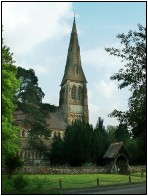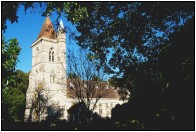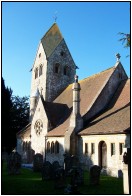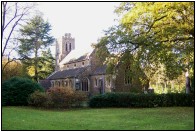| |
 
VICTORIAN
ARCHITECTS
 |
|
In a recent
article I told how the celebrated
architect, Sir George Gilbert Scott was
commissioned to build the new church at
West Meon, a commission that cost the
good rector, Archdeacon Bayley, some
£16,000. Although Scott was a young man
at the time, he went on to design such
monuments at St. Pancras Station, the
Foreign Office and the Albert Memorial in
Kensington Gardens. Yet he was far from
alone in plying his trade locally, even
though two of the best known Victorian
architects, Augustus Pugin, who built the
Palace of Westminster, and Joseph Paxman,
creator if the Crystal Palace, are
missing. The
most prolific was Sir Arthur Blomfield,
an architect who could be surprisingly
mundane, but when the money was
available, as it was from the Nicholson
family at Privett, he could design
buildings of the finest quality.
|
Pevsner’s Buildings of
Hampshire, the bible of all lovers of
architecture, describes his St. Mary’s, Liss
as dignified and dull, and compared with his best
work, like Holy Trinity at Privett or St.
Mary’s, Portsea, it certainly is. But then,
Holy Trinity cost £22,000
Money was without doubt an important factor in
the creation of the model village at Blackmoor.
In 1865 Sir Roundell Palmer, first Earl of
Selborne, commissioned Sir Alfred Waterhouse to
build a church, school and several houses,
culminating in Blackmoor House.
| Waterhouse was a
Quaker, born in Manchester, where much of
his work, including Strangeways prison,
survives today. He was known as the
Terra-cotta King, on account of the red
colour of his two best known buildings,
the Natural History Museum and the former
Prudential Assurance Building in Holborn.
He also used the round-headed Norman arch
far more freely than other Victorian
architects. St.
Matthew’s Church, Blackmoor, was
completed in 1868, and is notable for its
fine tower with a pyramid roof.
|
|
 |
The school, now the village hall,
was opened shortly afterwards and Blackmoor House
completed in 1873, though Waterhouse himself
designed additions ten years later. Sir Herbert
Baker’s War Memorial Cloister completes a
perfect village picture.
Less well known that the others,
Samuel Sanders Teulon designed Hawkley Hurst for
J.J. Maberly in 1860, who then employed him to
rebuild the village church. Teulon received a
large number of Royal commissions, and his work
can be seen on the Royal Estate at Windsor and at
Elvetham hall, near Fleet.
 |
|
He was considered
a rogue architect by his contemporaries,
and noted for his vigorous and often
highly original interpretation of the
Gothic style. There is, however, nothing
original about the tower at Hawkley , for
it is a copy of the famous Rhenish helm
at Sompting, near Worthing, but inside
Teulon lets his imagination take fire.
The round columns and huge carved
capitals create a Spanish, almost
Moorish, effect and the richly decorated
entrance to the north chapel, originally
the family pew, is pure conceit. There is one more well known
name to consider: G.E. Street, another
Gothic revivalist and designer of the
Royal Courts of Justice. The new church
at Milland, built in 1877 to replace the
old chapel which had fallen into
disrepair, was largely due to the efforts
of the then vicar, Rev. E. Durnford.
|
Land was given by Sir John Hawkshaw
of Hollycombe, who was a major benefactor for the
inhabitants of the Milland valley, and many
others contributed financially towards the £4000
required by Street and his builders.
Street’s building was always controversial,
and Pevsner describes it as a nasty, fussy job -
too cruel, perhaps, for there is no denying its
beautiful woodland setting.
| So here, on our
doorstep, we have buildings by Scott,
Blomfield, Waterhouse, Teulon and Street,
all leading practitioners of their time.
What of the 20th century? Lutyens, Basil
Spence, Norman Foster, Richard Rogers?
Lutyens designed Monkton House, hidden
away in the Downs north of Singleton;
Spence was responsible for several
buildings at Southampton University,
hardly close by, but I doubt if the last
two have anything around here. In fact, other than
Petersfield Library and the Olivier
Theatre and new Admin Block at Bedales,
where are there any contemporary
buildings of real quality? I’d love
to know.
|
|
 |
Tom Muckley, December 2006
Since this
article appeared I have been informed by Mr Sam
Pope, Churchwarden of St. Lukes, Milland with
Rake, that St. Luke’s was not the work of
G.E. Street, but a local architect, William
Street, who was brother of the principal
benefactor, George Street, of Heathmount, Rake.
This article was originally
published by the
Petersfield Post
tommuckley.co.uk
|
|





